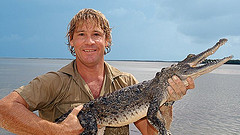How Much of Wildlife Filmmaking is Staged?

You’ve probably wondered how wildlife filmmakers are able to follow a polar bear and her cub across a year. Or get perfect close-up shots of a bear feasting on a deer carcass. In a new book, veteran wildlife filmmaker Chris Palmer offers an insider’s look at the practices (and secrets) of the wildlife film industry. What he describes will surprise you.
Palmer directs the Center for Environmental Filmmaking in the School of Communication at American University and he is the author of the recently published Shooting in the Wild: An Insider’s Account of Movies in the Animal Kingdom (Sierra Books). A lengthy feature at the Washington Post today describes some of the more revealing details from Palmer’s book and also the debate within the industry that it has triggered. Here’s a key excerpt:
Nature documentaries “carry the promise of authenticity,” Palmer said, speaking on a morning stroll through the manufactured wilderness of the National Zoo. Nature filmmakers profess to present animal life as it is lived, untouched by mankind. Yet human fingerprints are everywhere.
Palmer’s book underscores the fundamental challenge of wildlife filmmaking: Nature is frequently boring. Wild animals prefer not to be seen.
“If you sit in the wild and watch wildlife, nothing happens for a very long time,” said Maggie Burnette Stogner, an environmental filmmaker who works with Palmer on the American University faculty. “That’s mostly what happens in wildlife.”
Nature footage is hard-earned. A crew might spend six weeks in discomfort and tedium for a few moments of dramatic cinema. Certain shots — animal births, or predators seizing prey — are difficult to capture by chance. So some filmmakers set them up.
The lemmings that plunge to their deaths in the 1958 Disney documentary “White Wilderness” were hurled ingloriously to their doom by members of the crew, as a Canadian documentary revealed. Palmer writes that Marlin Perkins, host of television’s “Wild Kingdom,” was known to bait animals into combat and to film captive beasts deposited into the wild, and that the avian stars of the 2001 film “Winged Migration” were trained to fly around cameras.
Palmer asserts that manipulation pervades his field. Game farms, he writes, have built a cottage industry around supplying nature programs with exotic animals. Much of the sound in wildlife films is manufactured in the studio. Interactions between predator and prey are routinely staged.
“And if you see a bear feeding on a deer carcass in a film,” Palmer writes, “it is almost certainly a tame bear searching for hidden jellybeans in the entrails of the deer’s stomach.”
Even David Attenborough, the dean of British environmental filmmaking, admitted arranging for scorpions to mate in a studio, “with a painted sunset and Styrofoam clouds” as a backdrop, Palmer writes.
Palmer says he believes he is the first industry insider to pen a tell-all book. Diplomatic and meticulously fair, he has won praise from across the environmental filmmaking industry.
But not unanimous praise. Erik Nelson, a prolific environmental filmmaker in Los Angeles, finds “a sort of sanctimonious smugness to his book that sets my teeth on edge.”
Nelson is a glancing target in Palmer’s book; the author portrays Nelson’s eight-part television series “The Grizzly Man Diaries” as “sensational” and lambastes the animal-attack genre that Nelson helped to create. Nelson, in turn, asserts that Palmer has seldom actually shot a nature film — most of Palmer’s credits have come in the comparatively detached role of executive producer. He terms Palmer’s ethics crusade “a giant nothingburger of an issue.” (Palmer says he has been “deeply involved” in all of his films.)
And there has been other pushback. This fall, one cable channel executive rebuffed an invitation to speak to Palmer’s AU filmmaking class because of the fallout.
“Chris is taking a pretty bold step in doing this,” said Tom Campbell, a fellow filmmaker based in Santa Barbara, Calif. “Nobody really wants to speak out too much. If I say something bad about Discovery or Geographic, nobody’s going to hire me again.”
Below you can watch a 4 minute interview with Palmer about his book and his concerns with practices within the wildlife filmmaking industry. What do readers think? Are these practices troubling? Should programs do a better job of disclosing the staged nature of programming?





